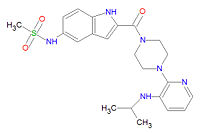Delavirdine: Difference between revisions
Jump to navigation
Jump to search

imported>David E. Volk m (center image, remove image credit (mine)) |
imported>David E. Volk mNo edit summary |
||
| Line 18: | Line 18: | ||
'''Delavirdine''' ('''DLV'''), also called '''SPP''', is an [[antiviral drug]] that is a non-nucleoside, reverse transcriptase inhibitor ([[nNRTI]]) specific for [[HIV]]-1. It binds directly to reverse transcriptase catalytic site and blocks the DNA polymerase activity. HIV-2 RT and eukaryotic (human, for example) DNA polymerases are not effected by this drug. Rashes are the major side effect of delavirdine toxicity, and they should be reported to the attending physician. Rashes typically are resolved in two weeks or less, but patients with severe rash or rash accompanied by fever, blistering, oral lesions, conjunctivitis, swelling, muscle or joint aches should discontinue medication and consult a physician. | '''Delavirdine''' ('''DLV'''), also called '''SPP''', is an [[antiviral drug]] that is a non-nucleoside, reverse transcriptase inhibitor ([[nNRTI]]) specific for [[HIV]]-1. It binds directly to reverse transcriptase catalytic site and blocks the DNA polymerase activity. HIV-2 RT and eukaryotic (human, for example) DNA polymerases are not effected by this drug. Rashes are the major side effect of delavirdine toxicity, and they should be reported to the attending physician. Rashes typically are resolved in two weeks or less, but patients with severe rash or rash accompanied by fever, blistering, oral lesions, conjunctivitis, swelling, muscle or joint aches should discontinue medication and consult a physician. | ||
Revision as of 15:53, 5 April 2009
|
| |||||||
| delavirdine | |||||||
| |||||||
| Uses: | HIV | ||||||
| Properties: | Reverse Transcriptase inhibitor | ||||||
| Hazards: | see drug interactions | ||||||
| |||||||
Delavirdine (DLV), also called SPP, is an antiviral drug that is a non-nucleoside, reverse transcriptase inhibitor (nNRTI) specific for HIV-1. It binds directly to reverse transcriptase catalytic site and blocks the DNA polymerase activity. HIV-2 RT and eukaryotic (human, for example) DNA polymerases are not effected by this drug. Rashes are the major side effect of delavirdine toxicity, and they should be reported to the attending physician. Rashes typically are resolved in two weeks or less, but patients with severe rash or rash accompanied by fever, blistering, oral lesions, conjunctivitis, swelling, muscle or joint aches should discontinue medication and consult a physician.
